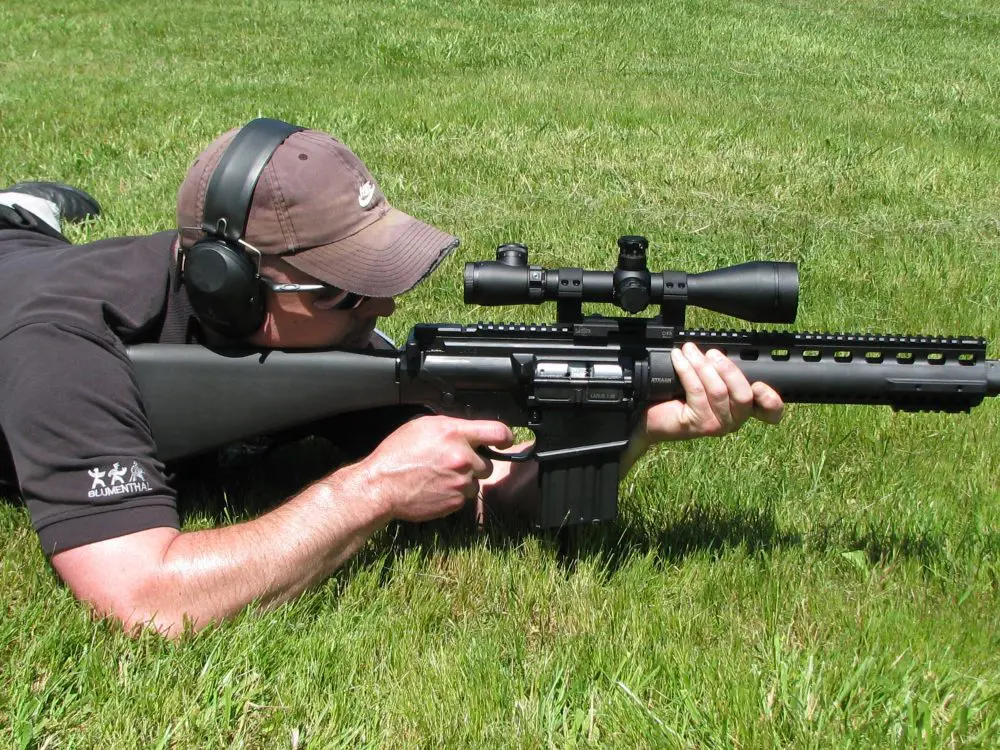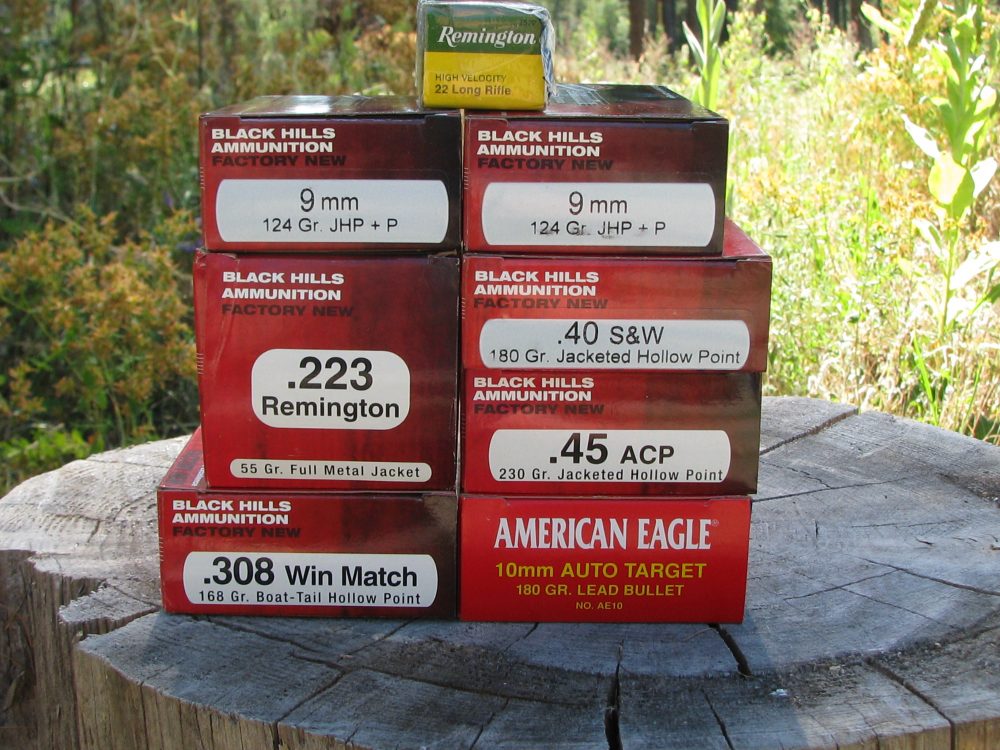I like to re-read books, because I’ll pick up things I missed the first time through. I’ve read some books a dozen times, and carry a couple with me constantly.
I was going through Survival Guns, written by Mel Tappan in 1976, for the umpteenth time when a light bulb came on—Mel was wrong. I love the book, I think it was a ground-breaking idea to use the words “survival” and “guns” in a title, and I think we should all read it. He was wrong, though, to recommend for use under stress a survival battery that had several different operating systems.
When I was a young trooper, I carried lots of different guns. I grabbed a gun depending on mood, weather, what I was wearing, the phase of the moon—no practical reason, just based on how I felt. I carried revolvers or auto-pistols, in everything from shoulder holsters to shoved in my belt, without rhyme or reason. I actually carried a Mauser Broomhandle for awhile, just ‘cuz I thought it was cool. It wasn’t until I was in a couple of scrapes that I realized I was still alive only because I was too stupid to get into Valhalla.
Steve McDaniel of Alaska Tactical runs Colt 9mm carbine.
Table of Contents
COMPETENCY
I only know a few guys who are “unconsciously competent” with several firearms platforms. I know and train with pistoleers, snipers, shotgunners, machine-gun guys, and carbine guys. Each of them is a wizard in his specialty, but not too many guys can pick up anything, shoot it well, and most importantly, run it well.
If it’s a system we don’t normally shoot, most of us have to think for a second or two. For example, I shoot an AR a lot, but when I pick up a .30-caliber carbine, I have to locate the safety and flip it a couple of times before I make ready.
Now, think of a guy who doesn’t have the time, money, location, or interest to train as much as he should to be ready when TSHTF.
He took advice from the local gun store or the guy behind the table at a gun show and owns a Mini-14, Mossberg 590, Marlin Camp Carbine in 9mm, S&W 4006, Kimber 1911, and Remington 700 in .308 for long-range work. He bought a couple of .22s, one an older Winchester bolt action, and a Ruger Mark 1 because it was a good deal. With this battery of guns, he’s going to protect the family and homestead in the dark days ahead.
All of these are good guns—I’ve owned and shot all of them. The problem is that each of the guns requires a different process to run, which makes it difficult to run them effectively under stress. Pat Rogers wrote a great piece on defaulting to zero if we don’t train hard enough (DEFAULTING TO ZERO: What’s Your Mindset? April 2012 S.W.A.T.). If we compound that problem by trying to use nine different operating systems, we’re in deep kimchee.
The good news is that we can limit the different systems we have to work with, so that our primary defensive weapons all work the same. There will still be a niche gun or two that works differently, like shotguns and revolvers, but we can limit that.
1911-type handguns in calibers from .22 LR to 10mm—and they all work the same.
WHAT TO CHOOSE?
Pistols
Your survival battery will vary mostly by where you live. If you live in a suburban area near a city and plan to remain there, a .338 Lapua sniper rifle isn’t necessary. You might decide that a couple of handguns and a .223 carbine will be all you need. Most of us carry handguns all the time, so we’ll talk about pistol systems first.
The idea of training in defensive firearms with a sub-caliber trainer isn’t new, but it has become popular lately.
The Service Ace came out in 1934, because ammo was too expensive and it was difficult to train new shooters on the .45. I have a series 70 Colt Ace and a Kimber .22 conversion unit—both work very well, and I can shoot literally ten times as much by shooting the .22. I can also carry a .22 pistol for grouse or other game birds while I carry a defensive long gun.
There are several top quality .22 carbines and several .22 conversion units out there. I’ve shot Colts and S&Ws extensively, and they work very well. One of my students shoots a conversion from Brownells and swears by it. This allows the user to build speed, skill at manipulations, accuracy, and hunt small game with the same gun at a fraction of the cost.
As regular readers know, I’m a 1911 guy. My primary defensive pistol is a Commander-size lightweight .45. I teach with several full-size government models, and have one Colt in 10mm. I own a Springfield EMP (the little 9mm that someone threw in a dryer and shrunk), a Browning P-35, and a Dan Wesson Guardian in 9mm. My primary defensive caliber is .45 ACP, and I have no intention of giving up “the man gun.” However, I don’t want to get shot with a 9mm. It’ll kill you just as dead as a .50, it’s good to shoot and carry, and ammo is inexpensive. Most of the plinking I do is with the .22 LR Ace.
Another great auto-pistol system is the Glock. Again, calibers from 9mm to 10mm, all kinds of modifications and sizes, all barrel lengths, anything anyone needs in a defensive pistol. If I were outfitting a family, I’d use the G17, maybe a 19 for carry, probably a 34 for fun. I would pay the money for a couple of the Advantage Arms .22 conversion units—they are truly outstanding and well worth the wait.
AR-type guns for any occasion. Left to right: .22 LR, 9mm, 5.56x45mm and .308.
Long Guns
Most Americans use the AR platform for defensive rifle work. It’s been the military standard for 50 years (the longest of any service rifle) and is still going strong. It’s also available in several different configurations and calibers. The primary caliber is 5.56mm, and it will handle most problems very nicely.
But it seems that everyone except the Cub Scouts is building and selling ARs today, so buyer beware—you do get what you pay for. I have one expensive gun—nicest AR I’ve ever had but no longer made. You don’t need to pay an excessive amount for a good gun. The flip side is that a $500 carbine might be too good to be true.
The pistol-caliber carbine will never go away. The first one I ever heard of was the 1873 Colt and Winchester combination—the cowboy, outlaw or lawman only had to worry about one round for both guns, which wasn’t a bad idea when logistics were—and could be again—a major problem.
Since I’m an AR guy, I tracked down a Colt 9mm SBR that came with a bunch of magazines. We can all whine about the 9mm lacking power, but a good hit with a 9mm is better than a loud miss with a .45, and someone intimidated by the blast of a .223 won’t have any problem with the 9mm carbine. Colt and several others are all making 9mm carbines and conversions, and if a 9mm is your primary handgun, a 9mm carbine is worth a thought.
Tom O’Connor of Leupold shoots LaRue Tactical OBR.
I sold off all my mag-fed .308s several years ago, figuring I really had no need for one. Everything in life is a circle, though, so I decided I needed one for uncertain times (it’s 296 yards from my porch to the bend in the road in front of my house).
I had the opportunity to get my hands on a LaRue Tactical OBR in .308. I only have about 350 rounds through it, but the OBR put three rounds of Black Hills 168-grain match through one hole at 100 yards, and I’m not a fantastic rifle shot. The OBR has a great trigger and runs flawlessly. With the rifle battery shown in the photos, I can train and shoot effectively from inside the house to as far as I can see.
For me, a side benefit of using the 1911 and the AR is that the manipulation of the safety/selector is virtually identical on both guns. When at the low ready with either gun, the thumb rests on the safety/selector. Once I decide to shoot, the gun comes up and the thumb manipulates the safety to the fire position (the safety “stays behind”). When I’m done shooting, the muzzle comes off and the thumb again moves the safety—very similar movements for both platforms, so I don’t have to learn as much.
The M14 is another long gun system. A Ruger Mini-14 in .223, an M1A in .308, possibly a .30-caliber carbine, and an M1 .22 from Legacy Sports (CARBINE UNDERSTUDY: Legacy Sports M-1 .22 Carbine, July 2012 S.W.A.T.) would offer the same versatility.
My only problem with the system is that the safety on the Mini and the M1A is located inside the trigger guard, requiring that the trigger finger go inside the guard to take the gun off safe. The .30-caliber carbine uses a different safety, located on the right side in front of the trigger, but running the bolt is the same on all of them.
Stock up on quality ammo in as few calibers as possible.
ESTABLISHING A SYSTEMS APPROACH
There are lots of ways to establish a systems approach. If you’re an AK fan, you can go from .22 to 7.62x54R calibers easily, and can also get a Saiga shotgun that works the same. You could use nothing but bolt or pump-action rifles that all work the same and not be undergunned.
I know we all want black rifles for the Zombie Apocalypse, but I’d hate to have a Montana elk hunter with his 7mm Remington Magnum eyeballing me through the glass…
The important thing is to find guns that work alike. If you’re just starting out, talk to folks and try different guns to see what works for you. If you hang around a range, see something interesting and ask, “Whatcha got there?” most guys will gladly tell you the virtues of their Atomic Blaster, and may let you pop off a round or two.
Keep it simple—you don’t need a ton of guns, just a few that will accomplish the mission and that you train hard with. Take an armorer’s class for each system and stockpile parts, accessories and magazines.
If you are working with others, standardize as to system and primary calibers. My defensive pistols are all 1911 pattern. ARs are my defensive long guns, and I train hard with them all. I also have Remington bolt guns and shotguns, but my calibers are very limited.
I have a shirt-tail relative who was an engineer. He buys all kinds of exotic guns because of the way they’re made. This might be fun as an intellectual exercise, but can get you killed if you need to use them.
When TSHTF, you won’t have time to figure out how to turn the damned gun on and make it run. It has to be fired without conscious thought. If it isn’t, you may not be able to make it go bang when it needs to.
SOURCES:
Advantage Arms (Glock conversions)
(661) 257-2290
www.advantagearms.com
Black Hills Ammunition
(605) 348-5150
www.black-hills.com
Brownells (.22-caliber AR conversions)
(800) 741-0015
www.brownells.com
Colt’s Manufacturing Company LLC
(800) 962-2658
www.coltsmfg.com
Glock, Inc.
(770) 432-1202
www.glock.com
Kimber America (.22-caliber 1911 conversions)
(888) 243-4522
www.kimberamerica.com
LaRue Tactical
(512) 259-1585
www.larue.com
Springfield Armory (rifles and pistols)
(800) 680-6866
www.springfield-armory.com











